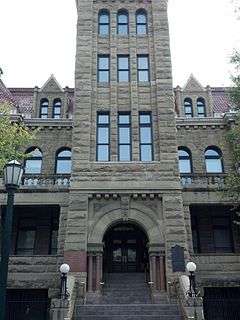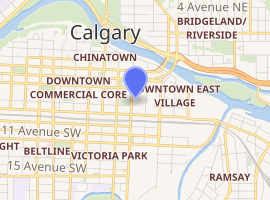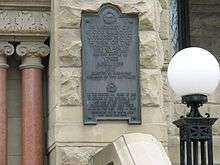Calgary City Hall
Calgary City Hall often called Old City Hall or Historic City Hall, is the office of the Mayor and Councillors for the Calgary City Council. Old City Hall housed the municipal council and portions of administration from its completion in 1911 until the construction of the Calgary Municipal Building adjacent to Old City Hall to house the offices of 2,000 civic administrators in 1985. Calgary City Hall is designated a National, Provincial and Municipal historical resource.
| Calgary City Hall | |
|---|---|
 | |

| |
| General information | |
| Type | Town hall |
| Architectural style | Romanesque Revival |
| Location | Calgary, Alberta |
| Address | 716 Macleod Trail SE, Calgary, AB T2G 5E6 |
| Coordinates | 51.0460°N 114.0574°W |
| Construction started | 1907 |
| Completed | June 26, 1911 |
| Cost | $300,000 in 1911 |
| Client | City of Calgary |
| Owner | City of Calgary |
| Technical details | |
| Floor count | 4 |
| Design and construction | |
| Architect | William M. Dodd |
| Official name | Calgary City Hall National Historic Site of Canada |
| Designated | 1984-11-23 |
| Official name | Calgary City Hall |
| Designated | 1978-10-18 |
Description
Calgary City Hall was designed by architect William M. Dodd to reflect Calgary's role as the urban centre in Southern Alberta. Dodd was known partnering with Edward Collis Hopkins to design the Regina City Hall (which was demolished in 1965) earlier, and had designed several buildings around the city. The site of the previous wood framed City Hall was chosen, and construction began in 1907 and was completed and opened by future Prime Minister Robert Borden on June 26, 1911.[1] By 1913, the building was already too small to house several civic services of quickly growing city. Dodd designed the building to embody Richardsonian Romanesque architectural style, which included a single clock tower (Seth Thomas Clock),[2] heavy stone exterior walls, bands of recessed windows, a recessed main entrance, stone arches and keystones above many windows and entries.[3]
Construction issues
The building was constructed with a steel structural frame supporting the Paskapoo Sandstone exterior, which became a common building material in the city following the Calgary Fire of 1886. The sandstone was originally sourced from the Bone and Oliver Quarry. Construction itself was filled with controversy and delays. Costs for the building continued to rise, and in April 1909 residents rejected a plebiscite for a bylaw providing additional funds for construction. Following the bylaws failure, Dodd withheld payment to the Alberta Building Company, which was responsible for construction, and the contractor walked off the job. Shortly afterwards in January 1910, architect William Dodd was fired and replaced with local firm Hodgson & Bates. Construction resumed following approval of a bylaw for additional funds in Spring 1910.[4] It is estimated the project cost a total of $300,000 by the time is was completed in 1911, approximately double the initial budget.[1]
Time capsule
In November 2018 as part of the restoration of the building, a time capsule was removed from cornerstone by Mayor Naheed Nenshi. The sealed copper box was placed by Calgary's 10th Mayor Arthur Leslie Cameron and former mayors George Murdoch and George Clift King on September 14, 1908. A number of items were included in the time capsule, such as a copy of the New Testament, official copy of bylaws, voters' list, various reports of city departments, various medals of various departments, and a copy of five newspapers circulating in the city.[5]
Plaque
A plaque at the entrance is dedicated to the memory of Lieutenant-Colonel Russell Lambert Boyle and the 10th Battalion, CEF. Boyle was a Calgary area rancher who was killed during the 2nd Battle of Ypres while commanding the 10th Battalion, which was recruited from Calgary and Winnipeg.[6]
The plaque reads:
IN MEMORY OF
Lt COL R.L. BOYLE
OFFICERS N.C.O.s
& MEN OF THE
TENTH BATTn
WHO FELL AT THE SECOND BATTLE OF
YPRES
APRIL 22nd
1915
ERECTED BY SURVIVING
MEMBERS OF THE BATTALION
After the Second World War the plaque was amended to honour The Calgary Highlanders by adding the following text underneath:
TO THE HONOUR AND GLORY OF GOD
IN MEMORY OF THE OFFICERS N.C.O.s
AND MEN OF THE CALGARY
HIGHLANDERS WHO GAVE THEIR
LIVES IN THE WAR 1939 - 1945
PERPETUATING UNIT OF 10th Bn C.E.F.
GOD SAVE OUR KING

Historic Site
On October 18, 1978, Calgary City Hall was designated as a Provincial Historical Resource, the designation notes the heritage value of old Calgary City Hall lies "with Calgary's historic status as the urban and economic centre of Southern Alberta, and its architectural significance as a monumental civic building."[3]
On November 23, 1984, Calgary City Hall was designated a National Historic Site with the name "Calgary City Hall National Historic Site of Canada". The designation referenced the historic value of the site as the only surviving example of a pre-1930s civic hall in the prairie cities, and the prominence of the Romanesque Revival style and clock tower.[7]
On April 17, 1990, the City of Calgary designated Calgary City Hall as the municipality's first Municipal Historic Resource under the Historical Resources Act.[8][1]
Status
The building is still used as an active office space for the Mayor and members of City Council, though most work, including council meetings, occurs at the adjacent Calgary Municipal Building.
Restoration
The quality, condition and cost of Calgary City Hall has been a civic debate since construction started in 1907, and the structure has undergone restoration a number of changes throughout its history. The first restoration occurred in 1962 at a cost of CA$2.5 million (equivalent to $20,974,843 in 2018) and addressed the interior and exterior of the building.[9] The second restoration took place in the late 1990s with a cost of CA$9.3 million (equivalent to $13,354,360 in 2018).[9]
In late 2014, Calgary City Council approved CA$34.1 million for renewal of Old Calgary City Hall.[10] Protective scaffolding was installed outside the building in 2014, as pieces of the original Paskapoo sandstone began falling from the building. According to one source: "The work is so extensive that it would force city council and staff to leave the premises for up to four years."[11]
References
- "The Making of Historic City Hall". Calgary.ca. The City of Calgary. Retrieved 12 May 2020.
- "City Hall's Famous Clock". Calgary.ca. City of Calgary. Retrieved 12 May 2020.
- "Calgary City Hall (Provincial Designation)". Canada's Historic Places. Parks Canada. Retrieved 12 May 2020.
- "Architect William M. Dodd". Calgary.ca. City of Calgary. Retrieved 12 May 2020.
- "110-year-old time capsule pulled from Calgary's Historic City Hall cornerstone". LiveWire Calgary. November 8, 2018. Retrieved 20 May 2020.
- "Calgary Highlanders monuments". Archived from the original on 2009-11-09. Retrieved 2015-10-29.
- "Calgary City Hall National Historic Site of Canada (Federal Designation)". Canada's Historic Places. Parks Canada. Retrieved 12 May 2020.
- "City Hall (Municipal Designation)". Canada's Historic Places. Parks Canada. Retrieved 12 May 2020.
- Stark, Erika (November 2, 2015). "Five things about historic City Hall". The Calgary Herald. Retrieved 20 May 2020.
- "Historic City Hall Heritage Rehabilitation". Calgary.ca. City of Calgary. Retrieved 12 May 2020.
- Dippel, Scott (October 29, 2015). "Calgary's old city hall in line for major $34M renovation". CBC News. Retrieved 12 May 2020.
External links
| Wikimedia Commons has media related to Calgary City Hall. |
- Calgary City Hall National Historic Site of Canada. Canadian Register of Historic Places. (Federal Historic Sites and Monuments Act Designation)
- Calgary City Hall. Canadian Register of Historic Places. - (Provincial Historical Resources Act Designation)
- Calgary City Hall. Canadian Register of Historic Places. - (Municipal Historical Resources Act Designation)